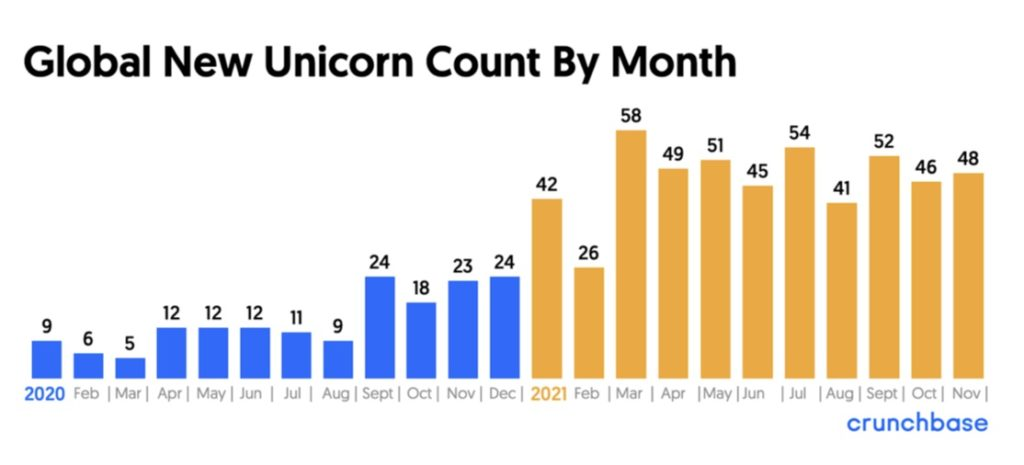How Entrepreneurs are Learning to Thrive in the Age of Digital Transformation

The Covid-19 pandemic has impacted how entrepreneurs operate all around the world. Although the emergence of lockdown and social distancing measures have heavily disrupted many industries in unprecedented ways, the ever-growing volume of emerging unicorns portrays a landscape that’s ripe for innovation.
As the relatively mild omicron variant of Covid-19 gives new hope for a future without restrictions, we’re already seeing entrepreneurs turn to the fresh wave of digital transformation in order to create more successful endeavours.

(Image: SeaStr)
As the Crunchbase data above suggests, the global new unicorn count across each month accelerated at a significant pace in 2021, averaging 46 new unicorns each month – a rate of 1.5 each day.
At its peak in March, we saw 58 fresh unicorns minted – more than double the highest posted in 2020.
Such impressive results point to a changing market, in which entrepreneurs can use more efficient digital tools to build thriving businesses. With this in mind, let’s take a deeper look into how digital transformation is helping the growth of entrepreneurs:
Utilizing Tools in the Digital Age
The pandemic forced businesses to think more digitally about their processes. As lockdowns and self-isolation measures became more widespread, workforces had to become more remote. By tapping into a variety of different digital platforms, businesses were able to reduce the risk of transmitting the virus whilst maintaining a degree of productivity.

(Image: The Economist)
Although the data above shows that results can vary dramatically depending on geography, on average, around 50% of workers around the world believe that working from home allows them to be more productive. Fundamentally, the pandemic may have shattered the perception that we’re at our best when in an office environment for good.
Remote workforces have been bolstered by collaborative tools like Zoom conference calls, Slack messaging services, and task delegation platforms like Monday. Video conferencing has also made its way into customer-facing industries too – helping to generate a better level of customer service.
Furthermore, cloud-based file-sharing platforms like Dropbox and OneDrive are helping to keep businesses more efficient without the necessity of meetings – with complex documents capable of becoming accessible instantly across a whole network of teams and staff members.
Of course, not all businesses are capable of operating on a fully remote basis. But as restrictions over Covid-19 ease, entrepreneurs will have to decide how to use their tools and the freedom of picking how distributed they want their workers to be.
In 2021, Microsoft released a short video providing insights into how a distributed workforce could function in an industry ripe for digital transformation. Whilst this is still relatively new, the growth of digital tools have paved the way for greater efficiency across a wide range of startups.
The Age of Smart Time Management
Not only has task delegation and internal data become far more digital in the wake of the Covid-19 pandemic, but also time management.
The recent emergence of smart speakers have opened the door to the prospects of personal service to help manage time, meetings, appointments, and projects throughout each day, but we’re now seeing an emerging trend wherein entrepreneurs are looking more to virtual assistants to help them.
Virtual assistants are generally freelancers who offer clients access to an array of services – usually on a wholly remote basis.
These virtual assistants will likely specialise in a specific field to better help the most pertinent concerns of their clients. For instance, some assistants might be fluent in accounting or QuickBooks, whilst others could be more social media or marketing based.
Time etc, a global virtual assistant service recognised by Investopedia, The Balance, and Fit Small Business as an industry leader, claims to have helped over 22,000 clients to save more than 1.2 million working hours through their team of vetted and experienced personal assistants online.
“Many ‘lockdown’ business owners will have put their heart and soul into their businesses, working 15 hour days, seven days a week,” said Katie Jenkins, who recently launched her own virtual assistant business, V2Pi.
“Some will now need to regain some work-life balance. Many tasks can be outsourced and that’s where virtual assistants like me come in. The best tasks to outsource to a virtual assistant are those which will save the client the most time and that are repeatable.”
Latching on to Big Data
Digital transformation has also made entrepreneurs far more aware of the actionable data they produce. This is significant because anomalies typically emerge from data that are both granular and high-frequency. Granular data generally reveals patterns that would otherwise be hidden by top-line averages, whilst high-frequency data allows emerging patterns to be swiftly identified.
This is particularly important in the age of the pandemic. As consumer and client behaviour changed in the wake of Covid-19, businesses quickly found themselves having to adapt rapidly to unprecedented circumstances.
For instance, sports events were found to have declined when events were cancelled, suggesting a behavioural rebound in the wake of lockdown measures, but granular data suggests that declining attendances were already underway prior to the shutdown of locations across the US – indicating that the shift in this industry was actually a consumer-driven occurrence.
Although the acceleration of digital transformation has pushed more brick and mortar businesses online, the new landscape can actually make it far easier for entrepreneurs to track the data that’s produced concerning their endeavours.
Through platforms like Google Analytics and Ahrefs, it’s possible to gain comprehensive insights into how visitors interact with websites and navigate through the funnels within. Cart abandonment can be pinpointed and investigated on the pages themselves and rectified in a matter of moments – whereas a physical cart abandonment can be far too nuanced to generate actionable insights.
For entrepreneurs, the age of digital transformation has helped to gain more thorough insights into what target audiences are like, and how they respond to marketing materials and various promotions.
Although the Covid-19 pandemic has been disruptive for industries on a global scale, the growing number of unicorns emerging over the past 12 months suggests that the digital transformation that it’s brought with it has enabled entrepreneurs around the world to thrive.
The post How Entrepreneurs are Learning to Thrive in the Age of Digital Transformation appeared first on ReadWrite.
(54)
Report Post





